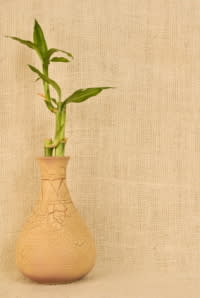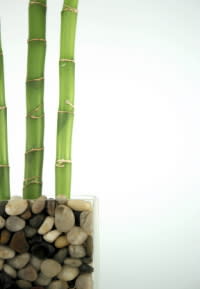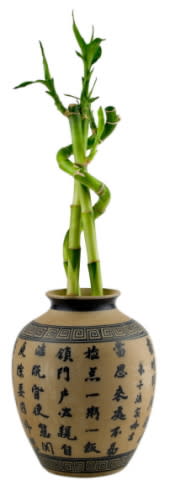Looking for an Ideal Office Plant? Try Lucky Bamboo
How would you like a nice green plant thriving in that dim & colorless office of yours or how about adding a touch of modern to your home decor? Here's a popular option that even the most beginner of green thumbs can make flourish, and it's believed to bring good luck too!

Awhile ago I was introduced to Lucky Bamboo by a family member and although it's been a very popular houseplant for a few years now, this was totally new to me-so of course I had to investigate. Here's what I've learned about growing and caring for it…
What Is It?
Guess what-it's not bamboo! It's a member of the lily family (Dracaena sanderiana) and grows in rainforests located in parts of Asia. This is a favored houseplant because it's so easy to grow and take care of. No need for potting soil, they are happy to grow in just water (Hydroponics). If you have a windowless office, this is one plant you should try-it thrives in both natural and artificial light.
How To Select
When determining which stalk is healthy and good to purchase, here are a few tips:
Both the water and the plant should smell fresh. If there's a funky odor, don't buy it.
Look for a firm stem and healthy white roots, black or brown spots on the tips are not good.
Choose a stalk with leaves that are bright green in color.
You may notice wax on the cut end of the stalk, this is to prevent fungus from getting into it as well as help the plant thrive.
If you want one that's curly (some believe the luck is stronger if it's curled), your best bet is to buy it already curled since it's so time consuming to train it to grow that way. They can get quite expensive the more elaborate the growth so you may opt to grow your own curled. This can be done, but you'll need a patient nature since it's very time consuming-I have some tips towards the bottom for you.
Keep in mind that the height of the stalk you buy is as large as the stalk will get. The shoots that develop off it (on the sides) will grow taller, but not the stalk.
Planting Tips

Take the stalk and rinse the stem and roots, look for any signs of decay and snip those off. Pinch off any yellow leaves.
Fill the container you wish to grow it in with rocks or marbles (or a mixture of both) at least 2″ deep. The container can be anything from a tall glass, a dainty vase or a decorative jar.
Place the stalk in the container and settle it into the rocks for support. Add room temperature distilled water about 1″ deep.
It can be placed anywhere but in direct sunlight, direct heat or chill.
You can arrange several stalks together in one container if you wish.
Water Tip:
You can use tap water instead of distilled but it's important to let the water sit uncovered for at least 24 hours before allowing the stalks to sit in it, this will help remove the chlorine, fluoride and other minerals from the water (it will suffer from this otherwise).
Container Tip:
Clear glass containers are popular because you can see the stones or marbles and the fresh water. However, direct light encourages algae growth in water. If you choose a clear container, be diligent with changing water regularly. If you want to change the water less, choose a solid colored container. The disadvantage of this is that you won't be able to see the rocks or monitor the water quality and amount as easily.
Soil Tip:
You can grow it in soil, but you need a good draining mixture to help it stay healthy. Use a mix of sand, peat moss and soil (equal ratio) and keep the soil moist rather than sopping wet. Keep the stalk at least 2″ deep. Make sure to have a few drainage holes in the pot as well as shards of pottery or rocks underneath the soil to ensure good drainage. Prevent root rot by allowing the top 1/2″ of the soil to dry out between watering.
How To Care For It
Caring for this plant really couldn't be easier, a few points though:

It needs to have fresh, clean water on a regular basis to prevent bacteria growth. Change the water weekly, some suggest even a bi-weekly change is fine. Keep an eye on the water, if it gets murky or cloudy or starts to smell-you know it's definitely time for a change.
When changing the water, inspect the roots and snip any that are starting to decay. Wash the container and the rocks well. Maintain the same level of water each time you fill the container, the water line is where the roots will form.
Give it a treat by occasionally misting it with distilled water, this will help the leaves from getting too dry as well as simulate it's natural habitat.
Keep it out of direct sunlight, direct heat and cool drafts.
You can trim it to keep it neat and from getting top heavy, but don't cut the stalk. When doing any trimming or cutting, make sure to use sterile scissors. You can wipe them clean with rubbing alcohol then once dry, use to snip. Trim shoot growth to about an inch from the main stalk.
You can occasionally feed with a mild fertilizer (every other month or so).
How To Propagate
Lucky Bamboo propagates very easily, simply take a cutting that has at least one leaf node and place in a cup of distilled water, new roots should appear after a few weeks. While waiting, make sure to replace the water frequently to keep it clean.
Once the roots have appeared and the cutting looks healthy, place it in the container with the other stalks or on it's own using the instructions above.
If you want the main plant to grow another shoot where you cut it, spray the cut daily with water. If you want to prevent growth, apply a bit of melted paraffin wax to seal the cut.
Cutting The Stalk
In some cases it may be necessary to cut the top healthy part away from the sick or rotting bit at the bottom of the stalk. You can try rooting the top healthy stalk by the method above, roots may appear for you after some time (no guarantee).
How To Make It Curl
It naturally grows straight up, to get it to curl is a test of patience and some skill. When you buy one with a curl, it's been trained to do so by expert growers. It will naturally grow toward the light, so the trick is to expose it to light from one direction only (curling will only happen with new growth). If you'd like to give it a shot, here's a common method:

Keep it in the container you have been growing it in.
Select a box which is large enough to cover it and give it some room for growth.
Cut out the bottom and one side of the box.
Place the box over the plant, this will cover it in darkness except for the one side you cut out.
Position the opening of the box to face the light, after some time it will start growing towards it (forming a bend).
Once you notice a bend, rotate the box one inch. The plant will adjust and grow with a deeper bend.
Continue until the desired curl has been achieved.
It will take about a year to achieve one curl, sometimes longer (that's why curled ones can be so expensive!).
Why Is It Considered Lucky?
They are associated with the practice of Feng Shui and because it's so hardy, it symbolizes good health. It's considered luckiest when received as a gift. A curling plant is also believed to hold great luck.
Meanings For The Number Of Stalks:

It grows in single stalks, some believe that arranging a certain amount of stalks together in a container holds special meaning and levels of luck. I've come across many lists, some suggesting different things for each amount but they generally follow this guide:
One: Simple Life
Two: Love; Double Luck
Three: Happiness; Good Luck; Longevity
Four: Death (avoid). The word four sounds nearly the same as the word death in Chinese, that's why it's avoided.
Five: Wealth; Health; Creativeness; Excitement
Six: Health; Happiness; Harmony
Seven: Health
Eight: Growth; Wealth; Prosperity; Abundance; Prospering Business
Nine: Good Fortune; Most Lucky
Ten: Perfection; Complete
Twenty-one: Powerful Blessings
